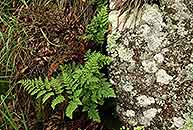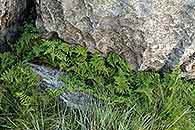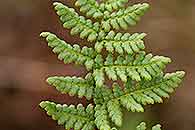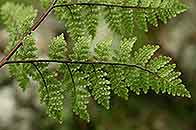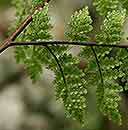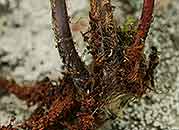Cheilanthes multifida (Sw.) Sw.
Synonyms |
Adiantum multifidum Sw. |
|---|---|
Common name |
|
Description |
Rhizome short, creeping, up to 4 mm in diameter; rhizome scales awl-shaped, margin (sub)entire, 4-7.5 mm long, brown with pale margins. Fronds monomorphic, tufted, 14-100 cm tall, erect, rigid, herbaceous to coriaceous. Stipe up to 42 cm long, dark brown to almost black, shiny, shallowly grooved, glabrous but with brown narrow scales at the extreme base. Lamina 3-pinnate to 5-pinnatifid, ovate-deltate in outline, lowest pinnae together almost as long as the lamina, basiscopically developed, 5-58 × 2.5-32 cm; pinnae in 5-12 pairs, oblong-ovate in outline, 2-19 x 1-12 cm; pinnules in 6-8 pairs, triangular-oblong to deltate-lanceolate in outline, 0.5-4.5 x 0.4-1.7 cm; ultimate segments oblong-ovate in outline, apex rounded, margin crenate, 0.2-1.5 x 0.1-0.7 cm, both surfaces subglabrous; venation visible or obscure, free; rhachis and secondary rhachises castaneous to black, hairless. Sori small, round, marginal, discrete; indusium small, semicircular, pale, erose to lacerate, membranous. |
Notes | Could be confused with C. bergiana or C. pentagona. C. bergiana is lightly hairy, has underground stolons and is a forest species. C. pentagona differs in having reddish-brown rhizome scales, a lamina that is less dissected (3- or 4-pinnatifid), pentagonal in outline and with visible venation.
|
Derivation | rmultifida: with many divisions, referring to the finely divided lamina. |
Habitat | In a variety of dry and wet habitats, but nearly always in rocky places; in rock crevices and around boulders in grassland, margins of sheetrock, forest margins in high rainfall areas. |
Distribution worldwide | Africa, Madagascar, St. Helena. |
Distribution in Africa |
Angola, Burundi, Dem. Republic of Congo, Ethiopia, Kenya, Lesotho, Malawi, Mozambique, Namibia, South Africa, Sudan and South Sudan, Swaziland, Tanzania , Zambia, Zimbabwe. |
Growth form |
Lithophytic, terrestrial. |
Literature |
|


